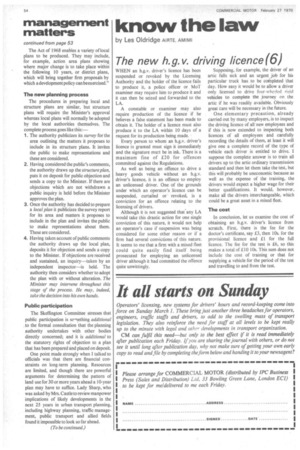know the law
Page 56

If you've noticed an error in this article please click here to report it so we can fix it.
by Les Oldridge AIRTE, AMIMI
The new h.g.v. driving licence(6)
WHEN an h.g.v. driver's licence has been suspended or revoked by the Licensing Authority and the holder of the licence fails to produce it, a police officer or . MoT examiner may require him to produce it and it can then be seized and forwarded to the LA.
A constable or examiner may also require production of the licence if he believes a false statement has been made to obtain it. The holder of a licence must also produce it to the LA within 10 days of a request for its production being made.
Every person to whom an h.g.v. driver's licence is granted must sign it immediately and the signature must be in ink. There is a maximum fine of £20 for offences committed against the Regulations.
As well as being an offence to drive a heavy goods vehicle without an h.g.v. driver's licence, it is an offence to employ an unlicensed driver. One of the grounds under which an operator's licence can be suspended, curtailed or revoked, is a conviction for an offence relating to the licensing of drivers.
Although it is not suggested that any LA would take this drastic action for one single conviction of this nature, it would not help an operator's case if suspension was being considered for some other reason or if a firm had several convictions of this nature. It seems to me that a firm with a mixed fleet could quite easily find itself being prosecuted for employing an unlicensed driver although it had committed the offence quite unwittingly. Supposing, for example, the driver of an artic falls sick and an urgent job for his particular truck has to be coiiipleted that day. How easy it would be to allow a driver only licensed to drive four whHed ritid vehicles to complete the journey on the artic if he was readily available. Obviously great care will be necessary in the future.
One elementary precaution, already carried out by many employers, is to inspect the driving licence of all new employees and if this is now extended to inspecting both licences of all employees and carefully recording the details of them, at least it will give one a complete record of the type of vehicle each driver is entitled to drive. I suppose the complete answer is to train all drivers up to the artic ordinary transmission standard and then let them take the test, but this will probably be uneconomic because as well as the expense of the training, the drivers would expect a higher wage for their better qualifications. It would, however, make all the drivers interchangeable, which could be a great asset in a mixed fleet.
The cost In conclusion, let us examine the cost of obtaining an h.g.v. driver's licence from scratch. First, there is the fee for the doctor's certificate, say £3, then 10s. for the provisional licence and £1 for the full licence. The fee for the test is £6, so this makes a total of £10 10s. This sum does not include the cost of training or that for supplying a vehicle for the period of the test and travelling to and from the test.




































































































